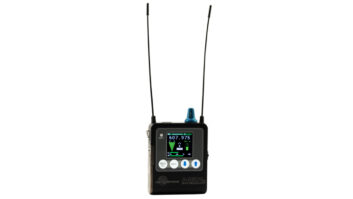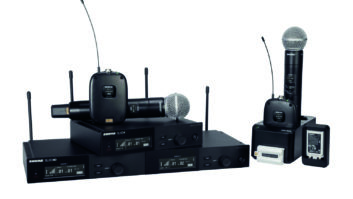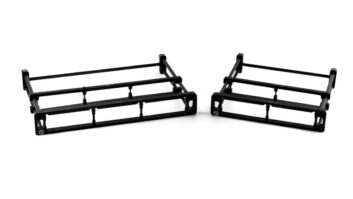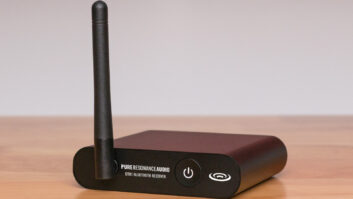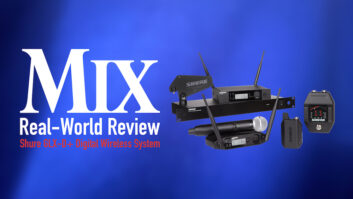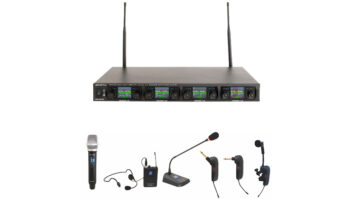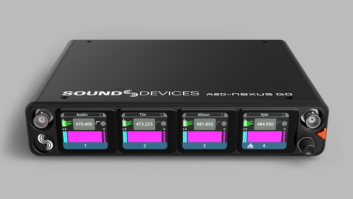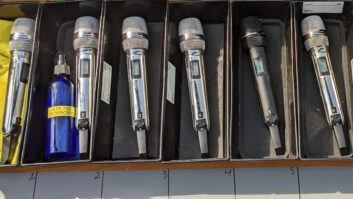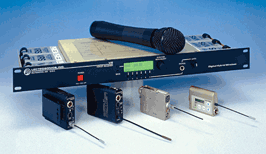
Today’s pro wireless audio systems face tremendous demands. Along with “traditional” interference sources — such as radio and television — increased RF traffic from consumer wireless technologies is becoming problematic. (See April 2007, “The Sky is Falling” for more on this timely issue.) Lectrosonics’ Venue Hybrid Wireless modular receiver system is designed to combat interfering technologies with multiple independent, configurable diversity receivers, all housed in a $1,495 VR rack chassis. Complementing the VR are Lectrosonics’ transmitters, including the LM/IM beltpack ($685), SM Series miniature transmitter ($1,710) and the VMS handheld transmitter ($1,860).
HOW IT WORKS
Lectrosonics’ Digital Hybrid Wireless technology is a multistage process employing proprietary software, whereby analog audio is converted into digital information. Digital audio is encoded back into an analog signal, which can be broadcast via FM. The information transmitted is encoded, yielding an inherently low noise floor without the need for companding. As the transmission itself is analog, efficiency and transmission range are increased. The technology also enables VR and SM transmitters to be backward-compatible with Lectrosonics’ 100, 200 and IFB wireless systems, as well as with certain Shure and Sennheiser wireless products.
The Venue chassis has six small bays, each holding a discrete $395 receiver module. Modules are user-installable and factory-tuned to frequency “blocks,” facilitating system expansion without creating conflicting frequencies. The VR frame can tune across two blocks, and transmitters can broadcast within one block. Nine blocks are available in the UHF band. The VR rear panel provides a balanced XLR audio out for each receiver, as well as two antenna I/Os and a threaded jack for the line-lump power supply. I was happy to see a locking collar for the DC plug, but it is possible to manipulate the DC plug so that the receiver loses power, although this never occurred during my road tests.
PACKED ON THE TRUCK
Initial setup of the VR was easy, as the unit provides two methods of locating open frequencies. The first is by selecting a receiver and a tuning group, and then scrolling through the tuning group’s eight preset frequencies while watching that receiver’s signal strength on the front panel LCD. No signal means that the channel is clear. I found the second method, using the VR’s Scan function, much more engaging. By selecting Scan, the VR analyzes the local RF spectrum and displays busy frequencies as black spikes on the LCD. The graph is displayed while you move the cursor along the graph to find a blank area. As you scroll, the display indicates the frequency, and the receiver automatically tunes to that frequency. You can increase the display’s resolution by zooming in. This function was very effective, easy to use and just plain cool. Set a transmitter to the same frequency and you’re off and running.
The VR receiver modules are configurable for three types of diversity operation. SmartDiversity™ uses antenna phase for best signal reception with one module. OptiBlend™ ratio diversity uses two receivers (1/2, 3/4 or 5/6) set to the same frequency with one transmitter. When you select ratio diversity on one receiver, the other is automatically set to the same channel. Either receiver’s XLR output produces the same audio signal, and the two receivers’ audio outs are internally mixed so the signal-to-noise ratio increases by 3 dB. We used this mode most of the time and it delivered clear, dropout-free performance. A third mode, Frequency Diversity, uses two transmitters and two receivers that are set to different frequencies. Audio output from both receivers is delivered to both XLR outputs in the pair, with the idea being that you would connect the outs to two channels on a mixing desk and raise both faders. If one receiver failed, the other would still deliver audio. In this mode, I found it possible to produce an audible thump by turning off one transmitter.
SOFTWARE AND EXTRAS
Using the included VRpanel software, diversity, frequency and mode settings can be stored/recalled via PC (there is no Mac OS support at present) for instantly resetting the unit for different applications or locations. For system setup/monitoring, VRpanel displays critical information (i.e., broadcast frequency, RF strength and transmitter battery status) for each receiver. This made it easy to check performance during a show, without being tied to the unit’s front panel.
Along with the VR and three transmitters, Lectrosonics sent a few goodies, including some deceptively simple-looking ¼-inch straight and right-angle instrument cables. These cables (as well as the lav and headset mics) connect to the SM and LM/IM beltpacks using a TA-type connector. (One minor gripe: When the connector is plugged in, the LM/IM beltpack’s audio level control is difficult to access.) Opening up the ¼-inch ends of the instrument cables reveals a miniature circuit board worthy of “007” status: a built-in active DI with a J-FET front end. This is why guitar and bass sounded so great through the VR: The instrument pickups are properly loaded so there’s no high-frequency loss. You have to tweak the audio output level to get the gain structure “right” with a guitar or bass rig, but once that’s done, the results are outstanding. Digital Hybrid mode exhibited no compression or transmission artifacts, nor any attenuation of high frequencies — often encountered with other wireless systems. The electret lav mic was quiet by wired standards, and you could even hear ambient background noise through the transmission process.
Other options include an adjustable antenna ($79) with built-in gauges that clearly show the distance to which they should be extended for specific frequency ranges — excellent! The battery compartments are very secure, so you don’t need to worry about intermittent operation from slightly undersized batteries. An optional SM transmitter remote control emits a modem-like chirp that can raise/lower the audio level, change the transmitter frequency or put the transmitter to sleep, allowing you to change settings without disturbing an actor’s or news anchor’s dress. It took a few tries and some experimenting with the volume level, distance and angle of the remote from the mic before the transmitter received the remote command, but this is great a option for theater use.
DID IT STAND UP TO THE TEST?
Bells and whistles aside, the true test of a wireless rig is RF performance. Here, the Lectrosonics VR is a champ. I used the VR system in a variety of locations including midtown Manhattan (an RF nightmare) with fantastic results. RF performance was impeccable with no dropouts or noise. The VRpanel software even provides a walk-test recorder that stores RF response data as you walk around a room to expose possible dead spots before a show. Used on guitar or bass, the LM/IM transmitter sounds as close to a wire as I have ever heard, and the battery life is excellent — the SM transmitter runs almost four hours on a single AA. (The LM ran almost seven hours on a 9-volt.) The Lectrosonics VR might seem a bit pricey, but it’s worth every cent.
Lectrosonics, 505/892-4501, www.lectro sonics.com.
